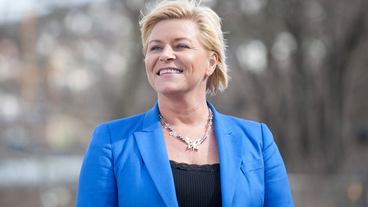The latest round of public opinion polls indicates that Norway’s non-socialist political parties, which have been sitting in opposition for the past eight years, are poised to win a solid majority in parliament at the September 9 election. The Progress Party and the Conservatives alone seem to have secured more than 50 percent of the vote.

The August party barometer compiled by research firm Norstat for Norwegian Broadcasting (NRK) shows that the Conservative Party (Høyre) remains Norway’s biggest with 29.7 percent of the vote, even though that was down by 1.7 percentage points from the last barometer in June.
Next in line is Labour (Arbeiderpartiet, Ap), which heads the current left-center coalition government, with 26.3 percent of the vote, down 1.2 percentage points since June.
In third place is a stronger Progress Party (Fremskrittspartiet, Frp), which logged the biggest gain of all the parties to land at 20.9 percent of the vote, up 3.2 percentage points from the June polls. That means it could form a non-socialist government with Høyre, which both parties have talked about for months, and they wouldn’t need the support of the much smaller non-socialist parties like the Christian Democrats (Kristelig Folkeparti, KrF), which was stable at 5.6 percent of the vote, and the Liberal Party (Venstre), which slipped again in the polls to just 3.4 percent, below the 4 percent usually needed for representation in Parliament.
The two other parties in the current left-center government did better, with both the Socialist Left party (SV) and the Center Party (Sp) landing over the 4 percent limit and giving their coalition with Labour 36.8 percent of the vote. That compares, though, to 50.6 percent held by Høyre and Frp, or 59.6 percent if all four non-socialist parties form a conservative coalition.
Rounding out the party barometer five weeks before Election Day were the small Reds party on the far left (Rødt) with 2 percent of the vote, and the environmental party MGD (Miljøpartiet de grønne) with 0.9 percent.
‘Dogfight ahead’
Political scientist and election statistician Bernt Aardal said on NRK’s nightly national newscast Dagsrevy that he now predicts “a real dogfight” among the parties in the weeks ahead. Labour is expected to fight hard to mobilize its supporters and attract more votes, as is Frp, which isn’t taking anything for granted.
Høyre and the other non-socialist parties, meanwhile, risk losing support on Election Day simply because some of their supporters may not bother to turn in ballots, believing that they’d already won. So they need to mobilize voters and urge them to cast ballots, too.
Polls by both newspaper VG and TV2 also indicate that Høyre and Frp are now strong enough to govern alone, even though Høyre leader Erna Solberg still claims she wants to form a government with Venstre and KrF as well. She may end up needing them after all, if complacency works against her in the voting booth.
All the party officials were quick to state once again that the only thing that really counts are the actual election results, although the new party barometer did indeed give Solberg and Frp leader Siv Jensen reason to smile.
newsinenglish.no/Nina Berglund

